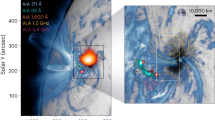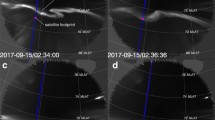Abstract
Aurorae are detected from all the magnetized planets in our Solar System, including Earth1. They are powered by magnetospheric current systems that lead to the precipitation of energetic electrons into the high-latitude regions of the upper atmosphere. In the case of the gas-giant planets, these aurorae include highly polarized radio emission at kilohertz and megahertz frequencies produced by the precipitating electrons2, as well as continuum and line emission in the infrared, optical, ultraviolet and X-ray parts of the spectrum, associated with the collisional excitation and heating of the hydrogen-dominated atmosphere3. Here we report simultaneous radio and optical spectroscopic observations of an object at the end of the stellar main sequence, located right at the boundary between stars and brown dwarfs, from which we have detected radio and optical auroral emissions both powered by magnetospheric currents. Whereas the magnetic activity of stars like our Sun is powered by processes that occur in their lower atmospheres, these aurorae are powered by processes originating much further out in the magnetosphere of the dwarf star that couple energy into the lower atmosphere. The dissipated power is at least four orders of magnitude larger than what is produced in the Jovian magnetosphere, revealing aurorae to be a potentially ubiquitous signature of large-scale magnetospheres that can scale to luminosities far greater than those observed in our Solar System. These magnetospheric current systems may also play a part in powering some of the weather phenomena reported on brown dwarfs.
This is a preview of subscription content, access via your institution
Access options
Subscribe to this journal
Receive 51 print issues and online access
$199.00 per year
only $3.90 per issue
Buy this article
- Purchase on Springer Link
- Instant access to full article PDF
Prices may be subject to local taxes which are calculated during checkout


Similar content being viewed by others
References
Badman, S. V. et al. Auroral processes at the giant planets: energy deposition, emission mechanisms, morphology and spectra. Space Sci. Rev. 187, 99–179 (2015)
Zarka, P. Auroral radio emissions at the outer planets: observations and theories. J. Geophys. Res. 103, 20159–20194 (1998)
Bhardwaj, A. & Gladstone, G. R. Auroral emissions of the giant planets. Rev. Geophys. 38, 295–353 (2000)
Reid, I. N. et al. Meeting the cool neighbors. IV. 2MASS 1835+32, a newly discovered M8.5 dwarf within 6 parsecs of the Sun. Astron. J. 125, 354–358 (2003)
Stelzer, B., Micela, G., Flaccomio, E., Neuhäuser, R. & Jayawardhana, R. X-ray emission of brown dwarfs: towards constraining the dependence on age, luminosity, and temperature. Astron. Astrophys. 448, 293–304 (2006)
Mohanty, S. & Basri, G. Rotation and activity in mid-M to L field dwarfs. Astrophys. J. 583, 451–472 (2003)
Berger, E. et al. Simultaneous multi-wavelength observations of magnetic activity in ultracool dwarfs. II. Mixed trends in VB 10 and LSR 1835+32 and the possible role of rotation. Astrophys. J. 676, 1307–1318 (2008)
Hallinan, G. et al. Confirmation of the electron cyclotron maser instability as the dominant source of radio emission from very low mass stars and brown dwarfs. Astrophys. J. 684, 644–653 (2008)
Berger, E. et al. Discovery of radio emission from the brown dwarf LP944–20. Nature 410, 338–340 (2001)
Hallinan, G. et al. Periodic bursts of coherent radio emission from an ultracool dwarf. Astrophys. J. 663, L25–L28 (2007)
Route, M. & Wolszczan, A. The Arecibo detection of the coolest radio-flaring brown dwarf. Astrophys. J. 747, L22–L25 (2012)
Harding, L. K. et al. Periodic optical variability of radio-detected ultracool dwarfs. Astrophys. J. 779, 101–122 (2013)
Littlefair, S. P. et al. Optical variability of the ultracool dwarf TVLM 513–46546: evidence for inhomogeneous dust clouds. Mon. Not. R. Astron. Soc. 391, L88–L92 (2008)
Berger, E. et al. Simultaneous multiwavelength observations of magnetic activity in ultracool dwarfs. I. The complex behavior of the M8.5 dwarf TVLM 513–46546. Astrophys. J. 673, 1080–1087 (2008)
Williams, P. K. G., Cook, B. A. & Berger, E. Trends in ultracool dwarf magnetism. I. X-ray suppression and radio enhancement. Astrophys. J. 785, 9–28 (2014)
Reiners, A. & Basri, G. A volume-limited sample of 63 M7–M9.5 dwarfs. II. Activity, magnetism, and the fade of the rotation-dominated dynamo. Astrophys. J. 710, 924–935 (2010)
Gray, D. F. The Observation and Analysis of Stellar Photospheres 3rd edn, Ch. 18 (Cambridge Univ. Press, 2005)
Zarka, P. Plasma interactions of exoplanets with their parent star and associated radio emissions. Planet. Space Sci. 55, 598–617 (2007)
Aboudarham, J. & Henoux, J. C. Non-thermal excitation and ionization of hydrogen in solar flares. II—Effects on the temperature minimum region energy balance and white light flares. Astron. Astrophys. 174, 270–274 (1987)
Burgasser, A. J., Kirkpatrick, J. D., Liebert, J. & Burrows, A. The spectra of T dwarfs. II. Red optical data. Astrophys. J. 594, 510–524 (2003)
Artigau, E., Bouchard, S., Doyon, R. & Lafreniere, D. Photometric variability of the T2.5 brown dwarf SIMP J013656.5+093347: evidence for evolving weather patterns. Astrophys. J. 701, 1534–1539 (2009)
Radigan, J. et al. Large-amplitude variations of an L/T transition brown dwarf: multi-wavelength observations of patchy, high-contrast cloud features. Astrophys. J. 750, 105–128 (2012)
Robinson, T. D. & Marley, M. S. Temperature fluctuations as a source of brown dwarf variability. Astrophys. J. 785, 158–164 (2014)
Crossfield, I. J. M. et al. A global cloud map of the nearest known brown dwarf. Nature 505, 654–656 (2014)
Isbell, J., Dessler, A. J. & Waite, J. H., Jr Magnetospheric energization by interaction between planetary spin and the solar wind. J. Geophys. Res. 89, 10716–10722 (1984)
Hill, T. W. The Jovian auroral oval. J. Geophys. Res. 106, 8101–8108 (2001)
Cowley, S. W. H. & Bunce, E. J. Origin of the main auroral oval in Jupiter’s coupled magnetosphere-ionosphere system. Planet. Space Sci. 49, 1067–1088 (2001)
Goldreich, P. & Lynden-Bell, D. Io, a jovian unipolar inductor. Astrophys. J. 156, 59–78 (1969)
Schrijver, C. J. On a transition from solar-like coronae to rotation-dominated Jovian-like magnetospheres in ultracool main-sequence stars. Astrophys. J. 699, L148–L152 (2009)
Nichols, J. D. et al. Origin of electron cyclotron maser induced radio emissions at ultracool dwarfs: magnetosphere-ionosphere coupling currents. Astrophys. J. 760, 59–67 (2012)
Horne, K. Optimal spectrum extraction and other CCD reduction techniques. Publ. Astron. Soc. Pacif. 98, 609–617 (1986)
Bochanski, J. J., West, A. A., Hawley, S. L. & Covey, K. R. Low-mass dwarf template spectra from the Sloan Digital Sky Survey. Astron. J. 133, 531–544 (2007)
Allard, F. et al. The limiting effects of dust in brown dwarf model atmospheres. Astrophys. J. 556, 357–372 (2001)
Foreman-Mackey, D., Hogg, D. W., Lang, D. & Goodman, J. emcee: the MCMC hammer. Publ. Astron. Soc. Pacif. 125, 306–312 (2013)
Acknowledgements
We are grateful to T. Readhead, S. Kulkarni and J. McMullin for working to ensure that simultaneous Palomar and VLA observations could occur. We thank the staff of the Palomar Observatory, the W.M. Keck Observatory and the National Radio Astronomy Observatory for their support of this project. The W.M. Keck Observatory is operated as a scientific partnership among the California Institute of Technology, the University of California and the National Aeronautics and Space Administration. The Observatory was made possible by the generous financial support of the W.M. Keck Foundation. The VLA is operated by the National Radio Astronomy Observatory, a facility of the National Science Foundation operated under cooperative agreement by Associated Universities, Inc. Armagh Observatory is grant-aided by the Northern Ireland Department of Culture, Arts and Leisure. G.H. acknowledges the generous support of D. Castleman and H. Rosen. This material is based upon work supported by the National Science Foundation under grant number AST-1212226/DGE-1144469. G.C. acknowledges support from the University of Oxford and from STFC grant ST/M006190/1. We thank J. Linsky and P. Goldreich for comments on this manuscript.
Author information
Authors and Affiliations
Contributions
G.H., S.B., M.P.R., A.A., A.G., A.K., M.M.K. and J.G.D. proposed, planned and conducted the radio observations. G.H. and S.B. reduced the VLA data and the dynamic spectrum was output by S.B. G.H. interpreted the dynamic radio spectra. G.H., S.P.L., G.C., R.P.B., J.S.P. and L.K.H. proposed and conducted the Keck observations. G.C. carried out the Palomar observations and reduced the publication data. S.P.L. and G.C. reduced the Keck spectroscopic data, with the final publication data delivered by S.P.L., G.H., G.C. and S.B. G.H., S.P.L. and J.S.P. developed the interpretation of the optical data. S.P.L. carried out the detailed model fitting of the Keck spectra. G.B. analysed high-resolution archival spectra and provided insight on interpretation of the optical data. S.V.B. coordinated contemporaneous spectropolarimetry with the observations presented in this paper. S.P.L. and G.H. wrote the Supplementary Information. All authors discussed the result and commented on the manuscript.
Corresponding author
Ethics declarations
Competing interests
The authors declare no competing financial interests.
Extended data figures and tables
Extended Data Figure 1 Posterior probability distributions for two-phase model parameters.
Greyscales with contours show our estimates of the joint posterior probability distributions for all combinations of parameters, while marginal posterior distributions are shown as histograms.
Extended Data Figure 2 The high state spectrum of LSR J1835 + 3259.
a, The high state spectrum of LSR J1835 + 3259 (black) is shown along with the model that best fits the high state spectrum (red). b, The residuals between the model and the fit.
PowerPoint slides
Rights and permissions
About this article
Cite this article
Hallinan, G., Littlefair, S., Cotter, G. et al. Magnetospherically driven optical and radio aurorae at the end of the stellar main sequence. Nature 523, 568–571 (2015). https://doi.org/10.1038/nature14619
Received:
Accepted:
Published:
Issue Date:
DOI: https://doi.org/10.1038/nature14619
This article is cited by
-
Detection of long-lasting aurora-like radio emission above a sunspot
Nature Astronomy (2023)
-
Resolved imaging confirms a radiation belt around an ultracool dwarf
Nature (2023)
-
Plasma Environment, Radiation, Structure, and Evolution of the Uranian System (PERSEUS): A Dedicated Orbiter Mission Concept to Study Space Physics at Uranus
Space Science Reviews (2023)
-
Far-ultraviolet aurora identified at comet 67P/Churyumov-Gerasimenko
Nature Astronomy (2020)
-
Coherent radio emission from a quiescent red dwarf indicative of star–planet interaction
Nature Astronomy (2020)
Comments
By submitting a comment you agree to abide by our Terms and Community Guidelines. If you find something abusive or that does not comply with our terms or guidelines please flag it as inappropriate.



